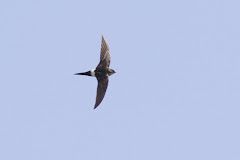Sparrowhawks lingered at the point, always on the look out for tired migrants taking a breather in the last few bushes before the sea.
I was at the point with Stig Kjaergaard Rasmussen, one of the regulars on southern Amager. He spent all morning on site and logged the following totals:
Chaffinch/Brambling 11,500; Linnet 165; Siskin 650; Crossbill 14; Meadow Pipit 585; Reed Bunting 348; Woodlark 22; Skylark 60; Grey Wagtail 7; Great Grey Shrike 1; Merlin 1; and Blue Tit 60.
It is always a little odd for me to see Blue Tits migrating and they are rather nervous migrants when confronted with water. The one in the photo below made 3 attempts to fly out to sea but, after a few hundred metres, returned to the last bush. Then, finally, it plucked up the confidence to go for it and the photo below shows it leaving the shore.
On a clear day it is possible to see the nearest land to the south at Stevns Klint. Many migrants fly west and then south around the bay but many also just fly out straight south across the bay. I have produced a crude google map that shows the observation point at Sydvestpynten and the main migration routes in Autumn.
Photos: Sparrowhawk looking for tired migrants; Blue Tit making its move; bye bye Blue Tit, see you next Spring!









No comments:
Post a Comment